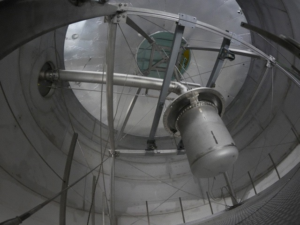
Dark Matter: From XENON100 to XENON1T
21 December 2014

The XENON1T dark matter detection experiment installation at the underground Gran Sasso National Laboratory. Part of the experiment is the yellow water tank in the middle, positioned between the already existing ICARUS (left, now moved to CERN) and the WARP (right, now removed) experiments (Source: Nikhef)
From Nikhef’s “Updates of the Experiments”: Latest developments in 2014 and expectations for the XENON Dark Matter program in 2015”
project is soon to enter a new phase with the most sensitive experiment for dark matter detection. While the successful XENON100 detector continues to take data at the Gran Sasso underground laboratory1, the new XENON1T is in construction since 2013. Located in the Hall B of the Gran Sasso underground laboratory, XENON1T will be the first to use a massive amount of liquid xenon, more than 3000 kg filling its sophisticated time projection chamber, to hunt for dark matter particles.
In the coming years, Nikhef researchers2 and their colleagues from fifteen different international universities and research institutes hope to contribute to answering many of the questions which remain open about the nature of dark matter. The last months were marked by the delivery and installation of the various systems which make XENON1T.
In January 2014, the water tank which will host the liquid xenon detector was completed. The suspension system for the detector, developed and built by Nikhef, was installed in May.
In August, the cryostat in which the detector will be mounted was delivered and installed in the water tank. Patrick Decowski, programme leader of the Dutch contribution to the XENON collaboration, says: “All major pieces of the detector are now in place and we are currently working on installing the systems that will allow xenon to remain cool and clean. At Nikhef we are mainly very busy with the detector readout and at the moment we are writing the related software. Our aim is to develop this in such a way that we can further increase the sensitivity of the detector with an improved readout”.
In the summer of 2015 XENON1T should be ready to receive data. Decowski says: “The heart of the detector is the smallest but of course most crucial part of the detector and this has yet to be installed. We expect that the first tests can take place in the spring of 2015”.
The scientists expect that XENON1T could surpass all existing dark matter detectors within a month, being 100 times more sensitive than any other detector. Decowski says: “I usually say that the search for dark matter is much like losing one’s keys and searching for them in the hallway, living room and kitchen, but not yet in the bedroom and bathroom. XENON1T will in no time go searching the last places in the house. Within a month we will have the first publication out to show all is working, then the second publication will come out within one year after the start. If we do find something we are of course not there yet, we will need to know what the characteristics of the detected particle are”3.
1 The experiment location, 1500 metres under the Grand Sasso mountain makes sure that as few cosmic muons as possible interfere with the experiment.
2 Nikhef’s researchers and engineers have contributed to the design of the cryostat in addition to its supporting structure. They also share the responsibility of the electronics and data-acquisition system.
3 When dark matter collides with the nucleus of a xenon atom, tiny light flashes will be produced. This light is generated by the recoil that the xenon atom has experienced. The XENON1T experiment will measure these light signals with high precision and through involved data analysis the researchers will prove the presence of dark matter. The detector can distinguish between the WIMP and possible leftover background radiation, so researchers hope that on the basis of the measurements they will be able to prove they detected a new subatomic particle and to determine its mass and what its likelihood of interaction with ordinary matter is exactly.
Submitted by Eleni Chatzichristou
APPEC Communications Officer
Further reading:
Original story (in Dutch) on XENON1T updates
Website of the XENON Dark Matter Project
Website of the XENON1T international collaboration
Website of XENON1T at Nikhef





